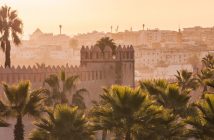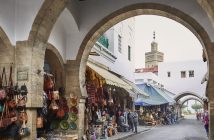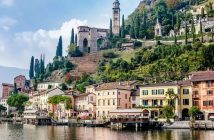With cruises on the rise, the opportunity to go further and more remote by sea becomes ever more available. Anna Selby boards a ship and ventures to the land of fire and ice, and beyond…
There are fewer and fewer places that are difficult to get to on this ever-shrinking planet of ours. And there are some places where a plane just doesn’t cut it and you have to go by another method altogether. Ship.
This is very much the case in the far north – countries such as Iceland and Greenland. Now, I do know access to Reykjavik is pretty easy by plane these days but planes don’t get you into distant fjords or up close to puffins and whales. So the Major and I embarked on a cruise that covered Iceland, Greenland and a quick stop in the very far north of Scotland on the way home.
Greenland has a special spot in the Major’s heart as he led an expedition there in the 90s and lived in tents on the ice cap for six weeks. This is not my method of travel. So this time around we were on board Fred Olsen’s Boudicca that has a rather superior level of comfort with big cabins, a tub in the bathroom and food on offer pretty much 24 hours a day. (The Major’s previous diet was dried food except for one day they discovered some mussels and cooked them up in melted snow.)
It’s over 1000 miles from Dover to Iceland and it took the best part of three days over a very placid sea to get there. Once you arrive, you feel like you’ve stepped into a geography textbook. Iceland has everything – glaciers, volcanoes, drifting tectonic plates, geysers, ice floes and a lot of thermal activity. It’s this thermal activity that supplies hot water direct to homes and swimming pools in Reykjavik. And one of its glacier supplies the purest drinking water literally on tap all over the capital. It is this glacier that is the focus of our first day.
 In 2010 when the Eyjafjallajökull volcano (beloved of newsreaders everywhere) erupted, it closed most of Europe’s skies. In Iceland, though, there was little disruption (their airport never closed) but it did result in exposing the Langjokull glacier so that they could map it, work out where the dangerous crevasses were and then – and what an idea this was – make a tunnel that would reach 45m below the surface and create a cave of ice.
In 2010 when the Eyjafjallajökull volcano (beloved of newsreaders everywhere) erupted, it closed most of Europe’s skies. In Iceland, though, there was little disruption (their airport never closed) but it did result in exposing the Langjokull glacier so that they could map it, work out where the dangerous crevasses were and then – and what an idea this was – make a tunnel that would reach 45m below the surface and create a cave of ice.
To get there, you need a vehicle equipped to drive over snow and ice, so we find ourselves in a giant 4×4 with tyres that reach almost to shoulder height. The tyres can be inflated and reflated at the touch of a button on the very complicated dashboard. We stop off just before hitting the ice to be equipped with overshoes and waterproofs – it “rains” we’re told once we’re inside the ice cave.
Langjokull is the second biggest glacier in Europe and measures 70x25km. We drive over a white desert into white cloud, the two merging until you don’t know where one ends and the other begins. Thank goodness the driver has a special glacier app. Suddenly, we’re outside a utilitarian looking tunnel that burrows down into the ice and introduced to our guide, Iris, who leads us into the heart of her gigantic ice cube.
This glacier is 3000 years old and the ice is 600m at its deepest though we’re only going 45m below the surface. Iris points out the dark line of volcanic ash that marks 2010 and a second lighter line, the result of a lesser eruption the following year. The two lines are around 3ft apart, representing a year’s snowfall that is gradually compressed and turns into glacial ice. You can see the process happening around you with the “younger” ice still with air bubbles that are gradually forced out as it becomes denser over time. There are ponds, rivulets, crevasses – and a chapel for weddings. There’s a special party place too – apparently Dolly Parton played here once (must have been a very small party).

The tour ends with the bad news. This 3000-year-old glacier will disappear totally during the next century. Long before that it will have shrunk to the extent that Reykjavik will lose its water supply. The glacial water will melt into the sea and the fish, overwhelmed by the fresh water, will disappear, too.
Iceland is endlessly fascinating. There are black lava fields and geothermal lakes (100C). Grey mud pools bubble and splash in a lunar landscape dotted with volcanic cones. The earth hisses, rumbles, groans – our planet at its most primitive, explosive and violent. There are extraordinary sights: the geological fault known as Almannagha where the American and Eurasian continents are pulling apart from each other and you can stand with a foot in each (see the photo of the Major astride the continents!); the original Geysir (after which all others are named) spouting into the sky surrounded by bubbling mud.
The next day we are in Isafjorour following this magical coastline of sparkling sea and the high green mountainsides that sweep smoothly down to its shores. It’s no surprise this is the land of saga – it is the stuff of legend itself. And extraordinary wildlife. We see Arctic terms, fulmars, puffins and eider. And in the fjord, three humpbacks appear. What more could we ask?

After another day at sea, we reach Greenland and spend a day “scenic cruising” in Prins Christiansund (often called a fjord but it is actually a sound as it’s open at both ends). This is the perfect antidote to high blood pressure. You’re on a slow and stately progress through breathtaking scenery – ice and rock, snow and glacier. There is an occasional iceberg and, in places, summer sun has melted the snow on the glaciers to reveal the blue ice beneath. It’s bare, elemental and beautiful. How anyone ever thought to live here is, though, another matter.
We don’t find that out for a while, though, as in this part of Greenland, it’s too inhospitable for anyone to live, let alone graze any animals, and it’s not till we get to Nanortalik on the comparatively habitable shores of southern Greenland that we see our first settlement.
Nanortalik has a special spot in the Major’s heart as this was where he stayed for one night before his expedition began. Little, he says, has changed. Nanortalik is a small settlement and its name means “the place where the polar bears go” but that seems to be happening increasingly rarely – another result of global warming – and this year none have been seen.

We visit the open-air museum, listen to the choir singing in the wooden church and, most spectacularly, see the locals dressed traditionally in skins taking out their kayaks. This is, of course, where these boats originated and in Greenlandic they are “qajaqs”. There is also the larger umiaq, often described as the women’s boat, in which the families and their supplies and belongings would take longer journeys. One of the locals demonstrates the Arctic Roll. No, in this instance it’s not a frozen dessert, it’s a technique for staying with your boat in the treacherous local waters. The boatman tips himself sideways into the freezing water, rolls the kayak over him and pops up on the other side as buoyant as a cork. This is just as well as most Icelanders, we’re told, never learn to swim.
The next day we are in Narsarsuaq, Erik the Red country. Erik (nicknamed for the colour of his beard) was on the run for murder when he arrived in Greenland and laid his claim in 982. He returned three years later with more settlers and a very successful sheep farming and fishing community was set up. The settlements in this part of Greenland became very wealthy, particularly with their trade in skins and walrus ivory used all over Europe to carve jewellery and trinkets. It was Erik’s son, Leif Eriksson, who was the first European to reach America.

Erik’s little village, Qagssiarsuk, has found remains of his original buildings and has recreated three of them. The tiny church has enough room for about three people to stand in – Erik’s wife introduced Christianity to Greenland, though Erik himself never converted. There is a grand long house with a turf roof and a tiny winter house, covered in turf and flowers where a family would overwinter for around five months. A tiny narrow tunnel is the entrance and the window – now glass – would have been a piece of seal membrane with a small hole so they could see if there was a seal in the water worth hunting.
It is a remarkably beautiful place and a wild one – eagles swoop low above our heads. As we head back across the fjord to the ship we pass hundreds of icebergs. Some of them have flipped over and are bright blue in the sunshine. One has sidled right up to the ship and is nudging the bow. Then, a huge tail flips just ahead of our mooring and an Orca makes his way back towards the sea.
A similar cruise with Fred. Olsen Cruise Lines in 2019 is the 16-night ‘Fjords of Greenland’ cruise on Boudicca (D1918) on 7th August 2019 from Dover and calling at Reykjavik, Qaqortoq, Narsarsuaq, Nanortalik and Kirkwall; and cruising through Prins Christiansund, Torssukátak and Tasermuit Fjord. Prices from £2399pp. For more information, including booking details and availability, visit www.fredolsencruises.com.
Photos by kind permission of the author.




